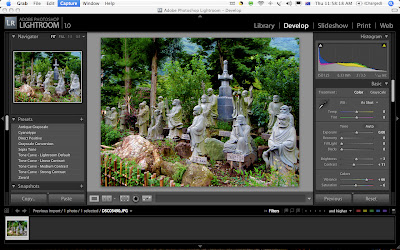The nice feature of this presentation was that it was an invitation-only professional event and so Gorman was able to pitch his discussion of processes at an expert technical level. The black and white conversion tutorial and raw conversion tutorial Gorman discussed are on his web site www.gormanphotography.com. These, it needs to be said, show toning and extreme contrasting reiterating Gorman's distinctive and assertive high contrast analogue black and white style. His signature style is characterised by sharp contrasts, stark lighting and natural lighting through windows, tight shots close in to the face with simple, usually dark or black backgrounds or dark greys.
Gorman stressed the importance of establishing a "unique and discriminating style", to develop an inherent style. In his own work, he aims for balance and harmony, simplicity of (dark) backgrounds, not always being explicit. The subject is the important part of the photo. He takes a traditional focus-on-the-eyes approach, sometimes with a single element to contribute to the semblance of style, such as Grace Jones' dominant hat. He accentuates strong highlights / harsh shadows, forms, lights, shadows. He mentioned the importance of communicating with subjects, afterall the difference between portrait photography and other is the consent and co-operation / facilitation of the subject. "Don't give up on your own ideas" he recommended, referring to his decision to shoot Kim Bassinger in an unconventional way. Andy Warhol's Interview magazine, as it was back in the 80s, was a good source of opportunities for portrait photographers, now over-processed and changed. From window lighting, Gorman likes the effusive wrapping quality. There was a stunning picture of Mark Wahlberg's abs! Gorman spoke of the increasing difficulty of accessibility of celebrities theses days, one reason he is starting to diversify and move into other areas, due to the array of psychopaths who surround celebrities. "Good images are created in the camera, not in PhotoShop" ... "see the light" not only in the sense of the light meter and auto balance but looking for lighting opportunities and interesting angles. He pursues more harsh lighting for black and white shots so increasing contrast and gamut are part of the B&W conversion process. Sometimes he intentionally chooses a higher ISO to accentuate the noisy/grainy aberration look more akin to old analogue images.

[Adobe Lightroom 1.0 screen-capture, click to enlarge view]
Most of Gorman's conversion and enhancing process occurs in Adobe Lightroom 1.0 Develop module in which there is an array of fine increments and adjustments - levels, luminosity, saturation, curves with clipping paths, levels in different regions [shadows, dark tones, mid-tones, light-tones], the usual exposure slider and wonderful unique recovery slider to pull in over-exposure in-camera blow-outs common in modern digital cameras. I really like this feature. Some of the additional subtlety lies in being able to control colouration of shadows, highlights, colour casting and lens correction for chromatic aberration and vignetting. It also allows rapid contact sheet production (much faster than PhotoShop). The purpose, however, was not a Lightroom plug but to illuminate the Epson print processes which permit black and white conversions in the print manager as an alternative to PS or LR. The other stuff, about paper types, colour management and not double colour managing in PS and Epson's print manager were revision but worthwhile reminders. Gorman uses these methods to make his own digital prints. For the B&W conversion in PS, Gorman uses lab colour and the colour channels and luminosity using curves on adjustment layers.





